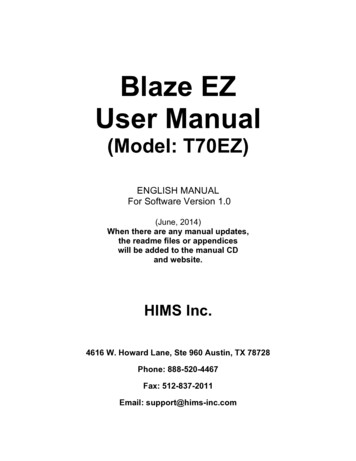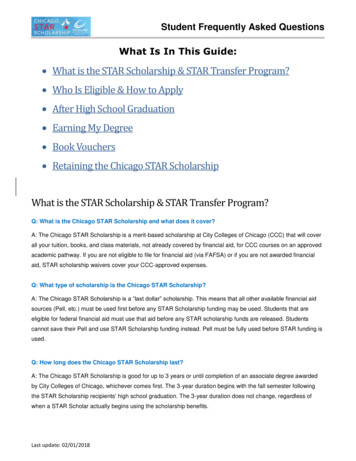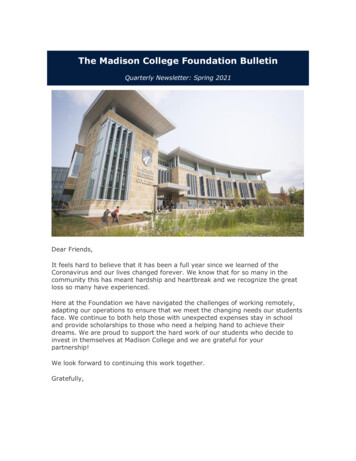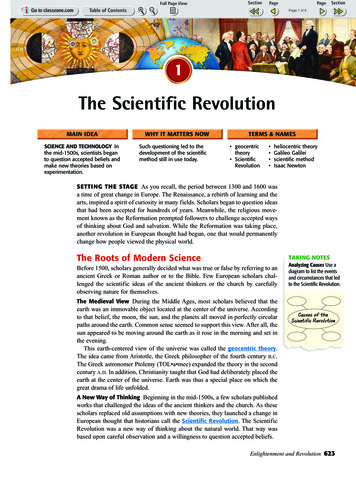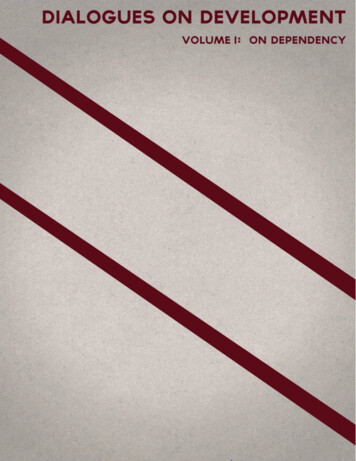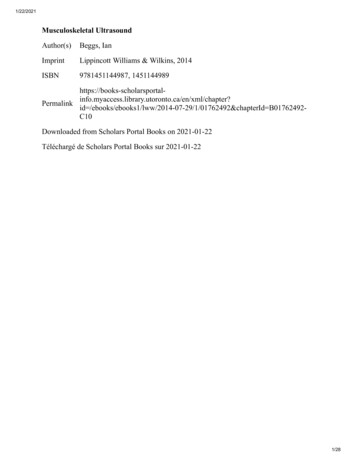
Transcription
1/22/2021Musculoskeletal UltrasoundAuthor(s)Beggs, IanImprintLippincott Williams & Wilkins, 2014ISBN9781451144987, s.library.utoronto.ca/en/xml/chapter?Permalinkid d B01762492C10Downloaded from Scholars Portal Books on 2021-01-22Téléchargé de Scholars Portal Books sur 2021-01-221/28
1/22/2021Chapter 10Inflammatory Joint DiseasesMichel Court-PayenMarcin SzkudlarekIan BeggsINTRODUCTIONUltrasound is increasingly used as a diagnostic modality in joint imaging by radiologists and rheumatologists. Several factorsexplain this development. Technical advances have improved image quality, simplified equipment, reduced cost, and improveddiagnostic capability. New, highly effective treatments have become available that control joint inflammation and prevent or retardlong-term joint damage, but early diagnosis of pre-destructive soft tissue changes is critical and best achieved by magneticresonance imaging (MRI) or ultrasound. With the exception of pre-erosions (subcortical bone edema) and assessment of articularcartilage, MRI and ultrasound are equally effective in the diagnosis of inflammatory arthropathy.1 Ultrasound is moreoperatordependent than MRI and cannot always access all parts of a joint (e.g., between metacarpal heads). However, ultrasoundhas better spatial resolution than MRI in superficial areas, can be used to scan multiple joints and sites quickly, and readilydistinguishes effusion from synovitis without needing intravenous contrast. Ultrasound is now viable as a diagnostic tool for officebased practice and for this reason has been adopted by many rheumatologists in their routine practice.In this chapter we will present the ultrasound technique and criteria for examining patients with arthropathies, and discuss initialdiagnosis and follow-up. We will discuss the ultrasound findings in conditions that target the synovial membrane (e.g., rheumatoidarthritis, juvenile idiopathic arthritis, and crystal arthropathies); inflammatory arthropathies that target both entheses and synovialmembrane (spondyloarthopathies); and other arthropathies (osteoarthritis, pigmented villonodular synovitis, synovialosteochondromatosis, amyloid, septic arthritis, and hemophiliac arthropathy). Finally, we will describe ultrasound-guidedinterventions.Although the cost of ultrasound equipment has reduced considerably in real terms, high-quality equipment remains essential. Highfrequency ( 10 MHz) linear array transducers are essential, although larger joints may need curvilinear transducers and lowerfrequencies. Small footprint transducers are useful for the small joints of the hands and feet. A standoff is not required, but copiousjelly helps. Beam steering and compound imaging are also useful. Joints should be relaxed when examined, and transducerpressure should be light or fluid may be displaced and missed or vascularity effaced.Tip:Use light transducer pressure or fluid or hyperemia may be missed.New developments are being assessed for possible roles in joint disease: 3D imaging (possible quantification of the volume ofinflamed synovium, regional vessels, or erosions); intravenous contrast agents (improved visualization of vascularity);elastography (compressibility of soft tissues); and fusion imaging (direct correlation of ultrasound to computed tomography [CT]and/or MRI). As yet, no practical applications for these techniques have been established in routine rheumatological practices.Standardization of technique and diagnoses has been facilitated by the adoption of a number of consensus definitions2:Synovial fluid: Intra-articular material that is displaceable and compressible and does not exhibit Doppler signal. It is usuallyanechoic (Fig. 10.1) or hypoechoic but may be hyperechoic.Synovial hypertrophy: Abnormal intra-articular tissue that is not displaceable and is poorly compressible. It may/may not exhibitDoppler signal and is usually hypoechoic (Figs. 10.2 and 10.3).Tenosynovitis: Thickened tissue ( / fluid) within a tendon sheath seen in two perpendicular planes. It may/may not exhibitDoppler signal and is usually hypoechoic (Figs. 10.4 and 10.5).Bone erosion: An intra-articular discontinuity in the bone surface that is visible in two perpendicular planes (Fig. 10.6).Enthesopathy: Abnormally hypoechoic and/or thickened tendon or ligament at its bony attachment with lossP. 222of the normal fibrillar pattern seen in two perpendicular planes. Echogenic foci due to calcification, Doppler signal, and bonychanges (due to enthesophytes, erosions, or irregularity) may be present.2/28
1/22/2021Figure 10.1. Longitudinal scan of anterior elbow. Anechoic effusion (eff) in anterior recess. B, brachialis muscle; C, coronoidprocess of ulna; H, humerus.In clinical practice, the diagnosis of “active arthritis” (or clinical synovitis) is based primarily on clinical evaluation, but it is oftendifficult to determine whetherP. 223joint pain, swelling, and/or limitation of mobility are caused by synovitis, tenosynovitis, enthesitis, or periarticular edema.Ultrasound has become a valuable adjunct in rheumatology. Ultrasound examination of joints demonstrates with high accuracymost of the anatomical structures involved: synovial recesses, articular/periarticular bone contours, ligaments, tendons, and tendonsheaths (including the bony insertions or entheses of ligaments and tendons), and bursae. Ultrasound can demonstrateinflammatory changes (hyperemia, synovial thickening, or effusion in joint recesses, bursae, or tendon sheaths) and destructivechanges (bone erosions, joint destruction or ankylosis, cartilage loss, and tendon tears).3/28
1/22/2021Figure 10.2. Patient with synovial hypertrophy (syn) in elbow. A: Transverse posteromedial ultrasound scan showing displacementof ulnar nerve (arrow). O, olecranon; ME, medial epicondyle of humerus. B: Power Doppler examination shows synovialhyperemia.4/28
1/22/2021Figure 10.3. Rheumatoid arthritis patients. A: Dorsal longitudinal ultrasound scan of the wrist shows synovial thickening in therecesses of the radiocarpal (arrow) and midcarpal (arrowhead) joints. Synovial hyperemia on power Doppler examination confirmsactive synovitis. Rad, radius; Lun, lunate; Cap, capitate B: Dorsal longitudinal ultrasound scan of the third MCP joint showssynovial thickening (syn) extending from the joint line and along the metacarpal head (M). P, proximal phalanx. C: Synovialhyperemia on color Doppler examination confirms active synovitis.5/28
1/22/2021Figure 10.4. Longitudinal (A) and transverse (B) scans of the extensor carpi ulnaris tendon (T) at the wrist of a patient with RAand tenosynovitis. The tendon is slightly enlarged. Effusion (ef ) and synovial thickening (S) in the tendon sheath. Color Doppler(A) shows tendon and synovial hyperemia. U, ulna; Triq, triquetrum.6/28
1/22/2021Figure 10.5. Tenosynovitis of the flexor digitorum tendons of the long finger (F). Longitudinal ultrasound scan shows effusion inthe flexor tendon sheath proximal (ef) and distal (ef3) to the carpal tunnel. Median nerve is enlarged proximal to the carpal tunnel(M) and compressed under the flexor retinaculum (arrow). R, radius; C, carpus.7/28
1/22/2021Figure 10.6. Dorsal longitudinal scans of second MTP joint in patient with RA. A: Synovial hypertrophy (syn) with erosion ofmetatarsal head (er). M, metatarsal head; P, proximal phalanx. B: Synovial hyperemia on color Doppler examination confirmsactive synovitis.Most of the early studies that described the ultrasound findings in inflammatory arthropathy were performed on patients withrheumatoid arthritis (RA), but these findings are not specific and can be found in most types of joint diseases.EXAMINATION TECHNIQUEIn general, joints are best examined with long-axis scans to show the joint recesses. Tendon sheaths are best studied in short axiswhen the transducer can be moved proximally and distally, employing an “elevator” technique. Bursae and Baker cysts are shownin two planes. Typical sites of synovitis include the ulnar aspect of theP. 224wrist, the metacarpophalangeal joints (MCPJs) especially the dorsal margins, and the suprapatellar recess of the knee.Hand and WristThe hand/wrist is the area most frequently examined for inflammatory arthropathy. Ultrasound anatomy and technique have beendescribed in Chapter 5 and will not be repeated in detail here, but a systematic approach to the examination is essential. The thumb8/28
1/22/2021and interphalangeal joints are not usually included unless there is a specific indication. By moving the transducer slowly, the entireexamination can be performed as a combined grayscale and Doppler procedure.Start by examining the dorsal aspects of the second to fifth MCPJs with the hand pronated, fingers extended, and the transducerplaced longitudinally (Fig. 10.7). Flexion at the wrist or MCPJs reduces the conspicuity of both grayscale and Doppler evidence ofsynovitis.3 With grayscale and Doppler gain and focal zone suitably adjusted, examine each joint in turn by moving the transducerslowly backward and forward from medial to lateral. At the second and fifth MCPJs, respectively, continue the movement toexamine the radial and ulnar aspects of the joints.Tip:The wrist and MCPJs should be extended when examined to optimize conspicuity of synovitis.Now place the transducer transversely on Lister tubercle to examine the second to fifth extensor compartments before internallyand externally rotating the wrist to examine the sixth and first extensor compartments, respectively. In each position, an “elevator”technique is employed by moving the transducer to and fro, proximally and distally. The transducer is then rotated through 90degrees on the dorsal aspect of the carpals and again moved backward and forward, from radial to ulnar, to examine the wrist andmidcarpal joints. The hand is then supinated and the transducer placed transversely across the carpal tunnel and moved proximallyand distally looking for evidence of flexor tenosynovitis. Finally, the volar aspects of the second to fifth MCPJs are examined insimilar fashion to the dorsal aspects.Figure 10.7. Dorsal longitudinal scan of normal second MCP joint showing normal capsule (arrowheads) and no synovialthickening. M, metacarpal head with anechoic cartilage (cart); P, proximal phalanx.Foot and AnkleA similar approach to the hand/wrist is used. The dorsal and plantar aspects of the metatarsophalangeal (MTP) joints and the dorsalmidfoot are examined with the transducer placed longitudinally. The medial, peroneal, and anterior tendons at the ankle areexamined transversely using a proximal and distal elevator technique, and the anteromedial and lateral gutters are also examinedtransversely.Other JointsAlthough long-axis scans of joints are usually preferred, short-axis scans can be useful, for example, in looking for fluid orsynovitis in the medial and lateral pouches of the suprapatellar recess of the knee.ULTRASOUND FINDINGS IN INFLAMMATORY JOINT DISEASESSynovitisDetection of synovitis is important because synovitis precedes bone erosions. Ultrasound is better than clinical examination andradiographs, and comparable to MRI in detecting synovitis.1 Synovial hypertrophy and joint fluid are both frequently present (Fig.10.8). Normal synovium is so thin it is not seen with ultrasound. Synovial hypertrophy produces solid, noncompressible, thickenedhypoechoic tissue in joints and tendon sheaths.2,4,5 The echogenicity of the thickened synovium is inversely proportional to itswater content: the more fluid that is present, the less echogenic the synovium. A semiquantitative grading system9/28
1/22/2021(normal/mild/moderate/large) for synovial hypertrophy may be employed.6 Joint or tendon sheath fluid is usually anechoic orhypoechoic, and compressible. A complex or echogenic appearance is due to proteinaceous fluid, crystals, or debris. Even in largeand easily palpable joints such as the knee, ultrasound is more sensitive in detecting fluid than clinical examination orradiographs.7,8 Volumes as small as 1 mLP. 225and interobserver agreement of 79% can be found in small joints of the hands and feet.8Figure 10.8. Transverse scan of suprapatellar recess of knee. Transducer pressure on right of image displaces fluid to left anddistinguishes effusion (eff) from synovial hypertrophy (syn).In patients with doubtful hypoechoic or anechoic areas in superficial joints, compression with the transducer9 distinguishesbetween synovial hypertrophy (poorly compressible, non-displaceable) and effusion (compressible, displaceable) (Fig. 10.8). Thisdoes not work for deep joints like the hip.Tip:Joint fluid is compressible and displaceable. Synovial thickening is poorly compressible and non-displaceable.Synovial hypertrophy occurs in both acute (inflammation) and chronic (fibrosis) stages of inflammatory joint disease, and it is notpossible to distinguish between them using grayscale ultrasound. Doppler techniques (color or power Doppler) are therefore widelyemployed for diagnosis and follow-up of arthritic joints.Tip:Use Doppler to distinguish between active and chronic (inactive) synovitis.Doppler techniques detect tissue hyperemia, which is associated with disease activity (Figs. 10.2 and 10.3). Some authors usepower Doppler. Depending on the sensitivity of the ultrasound equipment, others prefer color Doppler. Synovial hyperemia onDoppler ultrasound correlates well with contrast enhancement on MRI10,11 and microvascular density on histology.12 Synovialtissue may be seen extending into erosions (Fig. 10.6), sometimes with vascular signal,13 probably related to erosion activity (Fig.10.6). Fluid does not show Doppler signal and this helps to distinguish active synovitis from fluid. Light transducer pressure isessential as even moderate pressure may efface vessels and flow.Intravenous injection of ultrasound contrast has been used to increase the sensitivity of Doppler examinations.10,14,15 However,the sensitivity of current generation ultrasound machines has improved dramatically, even without contrast enhancement, and withhigh-end units it is now possible to display physiological joint flow.16 The use of intravenous ultrasound contrast increases the cost10/28
1/22/2021and time of the examination, and is invasive. Contrast is not used in routine clinical practice although it has been shown to improvethe diagnosis of sacroiliitis.17Doppler findings5 can be reported in three different ways: qualitative assessment, semiquantitative grading, and quantitativeassessment. Qualitative assessment is a simple report of the presence or absence of synovial flow. Semiquantitative scoring is themost often used technique in daily practice10,13 and employs a grading scale depending on the severity of findings.1 Quantitativeassessment18,19 is time-consuming but is more precise and is used for trials. It is performed by calculating the number of pixelsshowing power Doppler signal or by calculating the resistive index from spectral Doppler measurements. Future ultrasoundsystems may provide automatic measurements.Bony ChangesUltrasound of articular and periarticular bone surfaces can display erosions (Fig. 10.3), which are important signs in aggressivearthritis such as RA. Erosions are not disease-specific and can occur in other types of inflammatory joint disease. Small bonedefects resembling erosions can be found in healthy controls.20 Erosions typically occur in the bare area of a joint (i.e., theintracapsular cortex that is not covered by hyaline cartilage) and are seen as focal cortical defects identified in two perpendicularplanes. Active erosions may show Doppler signal (Fig. 10.6).Tip:Erosions usually occur at the bare area of a joint.Ultrasound is more sensitive than radiographs and comparable to MRI in detecting erosions in fingers21,22 or toes.1 The specificityof ultrasound is lower than that of CT, probably because small cortical defects occur as normal findings. Some studies have foundultrasound to be less sensitive in detecting erosions than MRI,23 possibly because of inaccessibility (e.g., on the lateral and medialmargins of metacarpal and metatarsal heads or at the wrist joint).1,22 A drawback of ultrasound is that it cannot detect bonemarrow edema, which has beenP. 226shown to be an important prognostic factor on MRI. Bone erosions in early undifferentiated arthritis increase the risk of developingpersistent arthritis.23Cartilage ChangesNormal hyaline or articular cartilage forms a hypoechoic layer that covers the bright surface of the subchondral bone plate. Itsthickness can be measured by ultrasound.9 The superficial surface of normal cartilage is seen as a smooth, thin echogenic line. Ininflammatory and degenerative joint diseases, nonspecific destructive cartilaginous changes can be detected with diffuse or focalthinning (Fig. 10.9), irregularity of the surface, or defects.TenosynovitisIn tenosynovitis, hypoechoic or anechoic fluid and/or synovial proliferation are seen around the tendon in the tendon sheath.Synovial hypertrophy may be nodular and show abnormal Doppler signal. Tendinopathy (with or without tenosynovitis) is definedby intratendinous changes: hypoechoic thickening best demonstrated on transverse scans, and disorganization of the fibrillartendon structure best seen on longitudinal scans. Paratendinitis is an inflammatory thickening of the para-tendon, which can bepronounced in some arthritides (RA, crystal or infectious arthritides, and juvenile idiopathic arthritis). Tendon tears are defined byareas of interruption of tendon fibers and may be partial (transverse or longitudinal with tendon split) or complete (transversetears). In aggressive inflammatory joint diseases such as RA, synovial tissue can enter tendon erosions, similarly to bony erosions.EnthesitisEnthesopathy refers to a pathological condition at the bony attachment of tendons, ligaments, capsule, or fascia, and can bemechanical or secondary to an inflammatory process (enthesitis). Enthesitis is characteristic of sero-negative spondyloarthropathiessuch as ankylosing spondylitis and psoriasis. Signs of inflammation in the spondyloarthropathies are more frequent at insertionsites than in the synovial membrane of joints or tendon sheaths. This is the opposite of RA24 and is useful when considering thedifferential diagnosis, although a specific diagnosis cannot be achieved with ultrasound alone.11/28
1/22/2021Figure 10.9. Transverse scan of femoral trochlea with knee in full flexion. Cartilage thinning and irregular hyperostosis are presenton lateral aspect of trochlea (arrow). Quad, Quadriceps tendon.Tip:Enthesitis is characteristic but not pathognomonic of seronegative spondyloarthropathy.The presence of inflammation at insertion sites is difficult to assess clinically. Radiographs show bony changes (enthesophytes,bony irregularity, and erosions) and tendon calcification at a late stage, often only after many years of symptoms.25 Ultrasound andMRI can demonstrate the early soft tissue signs of inflammation. Ultrasound shows the soft tissue part of insertion sites in greaterdetail than MRI, especially at small structures, and is a helpful adjunct to clinical examination. Ultrasound shows focal hypoechoicthickening of the tendon insertion in two orthogonal planes, sometimes with hyperemia, calcifications, or bony changes.2 Adjacentbursae may also be inflamed (e.g., enthesitis of the Achilles tendon and retrocalcaneal bursitis). As ultrasound can show only thesurface of bone at an enthesis, local bone edema is not detectable, and this is a disadvantage compared with water-sensitive MRIsequences (STIR, fat-suppressed T2-weighted) or fat-suppressed contrast-enhanced T1-weighted sequences.26 However, only largecalcifications or spurs can be seen on MRI, whereas ultrasound shows even small enthesophytes.Tip:Enthesitis typically results in the thickening of a tendon/ligament / hyperemia on Doppler or hyperostosis.BursitisMost peripheral bursae are accessible to ultrasound. Bursitis is diagnosed when a bursa is enlarged with fluid and synovialthickening or completely filled with synovial tissue (Fig. 10.10). Doppler signal may be present.Bursal fluid is often anechoic but inflammation, infection, blood, and crystals may result in echogenic fluid. Bursae occur at manysites, for example, the olecranon bursa at the elbow, the retrocalcaneal bursa at the ankle, the subacromial bursa of the shoulder andaround the knee.In patients with swelling and/or pain of the knee and/or popliteal fossa, a Baker cyst is easily diagnosed at ultrasound bydemonstrating a comma-shaped cyst with its characteristic neck between the medial head ofP. 227gastrocnemius and the semimembranosus tendon. The cyst may be filled with solid synovial tissue in inflammatory joint disease.Ultrasound identifies other causes of popliteal masses (tumor, aneurysm, ganglion cyst, hematoma, and abscess) and distinguishesbetween ruptured Baker cyst, when fluid is seen tracking along fascial planes, and deep venous thrombosis in patients with acuteleg swelling.12/28
1/22/2021Figure 10.10. Rheumatoid bursitis superficial to first metatarsophalangeal joint. Longitudinal ultrasound scan shows enlargedhypoechoic bursa (B) superficial to flexor hallucis longus tendon (T) and first metatarsal head (M).Adventitial bursae occur at sites of mechanical friction, often related to sports or occupation. They fill with fluid and do not have asynovial lining.INFLAMMATORY JOINT DISEASESRheumatoid ArthritisRA is a chronic, symmetric autoimmune disease characterized by joint inflammation, destruction of small and large joints, andextra-articular manifestations. Until 2010 it was diagnosed according to the American College of Rheumatology (ACR) 1987Classification Criteria27 based on clinical assessment, immunological markers (presence of rheumatoid factor), and conventionalradiography.The new 2010 European League Against Rheumatism (EULAR)/ACR Classification Criteria for RA28 allows ultrasound tosupplement the clinical examination. By showing the extent of joint involvement, the status of the disease may change from amono- or oligoarthritis to polyarthritis,29 thus potentially changing the diagnosis and instigating potent treatments. Only ultrasoundsigns of inflammation/synovitis play a role. No place is given to evidence of joint destruction although ultrasound has highsensitivity for the detection of bone erosions in small joints,1,21,30 particularly in early disease.22Typical symmetrical involvement of the wrist joints (most often around the styloid process of the ulna) (Fig. 10.11) and the smalljoints of the extremities can be easily detected with ultrasound (MCP-, MTP- and proximal interphalangeal [PIP]-joints).Tenosynovitis and possible tendon ruptures can also be detected (extensor carpi ulnaris and other extensor tendons, flexordigitorum tendons with carpal tunnel syndrome) (Fig. 10.12). Ultrasound shows all changes in joints affected by RA with theexception of bone edema and bone/cartilage damages in areas not accessible by ultrasound. Detection of joint effusion, synovialthickening, synovial hyperemia/inflammation with Doppler techniques, tendon pathology such as inflammation, fluid in tendonsheaths and bursae, tendon rupture, cartilage thinning, and bone erosions are all possible with ultrasound.Rheumatoid NodulesRheumatoid nodules are areas of fibrinoid necrosis surrounded by fibrous tissue seen in up to 25% of patients with RA, usuallywith active disease and high levels of rheumatoid factor. Nodules are usually subcutaneousP. 228and occur over bony prominences such as the olecranon process but can occur anywhere. Ultrasound shows a well-defined13/28
1/22/2021relatively hypoechoic mass often with a hypoechoic central area due to necrosis.31 Nodules in or adjacent to tendons may catch onretinacula or pulleys causing triggering.Figure 10.11. Rheumatoid arthritis patient. A: Hypoechoic synovial hypertrophy on ulnar aspect of wrist and around ulnar head(U). T, triquetrum. B: Synovial hyperemia around ulnar head on color Doppler examination is a sign of disease activity.14/28
1/22/2021Figure 10.12. Patient with rheumatoid arthritis. A: radiograph of wrist shows advanced erosive arthropathy. B: Ultrasound showscomplete tear (arrow) of extensor digiti minimi tendon (T). U, Ulnar head surrounded by hypoechoic synovitis.Assessment of Response to TreatmentUltrasound is widely used for follow-up of inflammatory arthropathy. Most studies have been on patients with RA. Clinicalexamination is insensitive at detecting low-level active synovitis32 although subclinical synovitis is important and predictssubsequent radiographic deterioration29,33 if not treated. Therapeutic efficacy can be monitored by ultrasound, which showsreduced synovial thickening and Doppler signal after intra-articular steroid injections and systemic treatment with antiTNF,34,35,36,37,38 and the resistive index may increase.19 Ultrasound also has potential for follow-up of erosive changes.Ultrasound detects more erosions than radiographs but fewer than MRI in the MCP and PIP joints of patients with RA.21,39Ultrasound can detect complications during treatment (e.g., soft tissue infection, tendon tear, and deep vein thrombosis).PrognosisThe role of ultrasound in the prognosis of RA has not been fully examined, but demonstration of synovial power Doppler signal inRA joints predicts radiographic progression.40,41 The grade of synovial hypertrophy, independent of Doppler signal, can play arole in predicting radiographic progression of RA.3315/28
s are a group of diseases with common features characterized by chronic joint inflammation, strongassociation with HLA B-27, predilection for the axial skeleton (spondylitis, sacroiliitis) and insertion sites (enthesitis), and lack ofassociation with rheumatoid factor (seronegativity). Conditions include ankylosing spondylitis, psoriatic arthritis, reactive arthritis,enteropathic arthritis, and undifferentiated spondyloarthropathy. Enthesitis is characteristic but not pathognomonic. Peripheral jointinvolvement is typically an asymmetric oligoarthritis with associated enthesitis, predominantly affecting the lower limbs. Extraarticular signs include anterior uveitis and mucocutaneous lesions. The prevalence of all types of spondyloarthropathies has beenreported between 0.5% and 1.9%. The diagnosis of spondyloarthropathy, regardless of etiology, is generally based on the EuropeanSpondyloarthropathy Study Group (ESSG) criteria,42 which include radiological sacroiliitis but not early ultrasonographic softtissue changes.Ultrasound of SpondyloarthropathyThe main sites of spondyloarthropathy, the spine and sacroiliac joints, are poorly visualized with ultrasound, although peripheralsigns of enthesitis, synovitis, tenosynovitis, bone erosions, and cartilaginous changes can be displayed by ultrasound, especiallyinflammatory and destructive changes at the calcaneal insertion of the Achilles tendon (Fig. 10.13). Ultrasound monitoring ofenthesitis during treatment can show significant improvement of the inflammatory changes.43Ankylosing SpondylitisAnkylosing spondylitis is the most common spondyloarthropathy, with a prevalence of up to 0.2%. Initial symptoms are insidious,typically in young adults, more often men than women, with axial involvement (sacroiliitis and spondylitis). The diagnosis is basedon clinical,P. 229radiographic, and biochemical features but is often delayed. Ultrasound can show peripheral asymmetric oligoarthritis (hip,shoulder, and lower limbs) and enthesitis (heel, iliac crest, and anterior chest wall). The hand is not frequently involved. Theprognosis is variable, but the disease has a tendency toward ankylosis of the spine and may lead to substantial functional loss andmusculoskeletal or ophthalmologic complications.Figure 10.13. Longitudinal scan of the insertion of the Achilles tendon (Ach) of a patient with spondyloarthropathy. Enthesitis withslight focal hypoechoic tendon enlargement, retrocalcaneal bursitis (B), and bone erosion (er) of the calcaneus (C). Color Dopplerexamination shows hyperemia in bursa, anterior tendon, and erosion.Psoriatic ArthritisPsoriatic arthritis is a chronic inflammatory joint disease associated with psoriasis. Skin disease is generally present, but 10% to15% of patients with joint involvement do not have cutaneous changes. The first symptoms often appear around 40 years of age,equally frequent in men and women. Any peripheral joint may be inflamed but an asymmetric oligo- or monoarthritis is typical,although polyarthritis is seen in 10% to 20% of patients. Sacroiliitis, spondylitis, enthesitis (Achilles tendon) (Fig. 10.14), synovitisof the small joints of the finger (especially the distal interphalangeal joints), and proliferative osseous changes are characteristicfindings. Dactylitis is a sausage-shaped swelling of fingers or toes secondary to joint synovitis, tenosynovitis, periostitis, andenthesitis. The prognosis is variable. It is often better than RA, but erosive changes may lead to arthritis mutilans and significantincapacity.16/28
1/22/2021Figure 10.14. Psoriatic arthritis. Longitudinal ultrasound scan of dorsal aspect of talonavicular joint shows synovial hypertrophy(syn) and thickening of the proximal insertion of the dorsal talonavicular ligament due to enthesitis (arrow). T, Talus; N, Navicular.Juvenile Idiopathic ArthritisJuvenile idiopathic arthritis (JIA) is not one disease but encompasses all forms of arthritis that begin before the age of 16 years,persist for 6 weeks, and are of unknown etiology. This group of conditions is distinct in many ways from RA in adults. Sevensubtypes are distinguished on the basis of clinical (intra-articular and extra-ar
Musculoskeletal Ultrasound Author(s) Beggs, Ian Imprint Lippincott Williams & Wilkins, 2014 ISBN 9781451144987, 1451144989 . Downloaded from Scholars Portal Books on 2021-01-22 Téléchargé de Scholars Portal Books sur 2021-01-22. 1/22/2021 2/ 28 Chapter 10 Inflammatory Join


